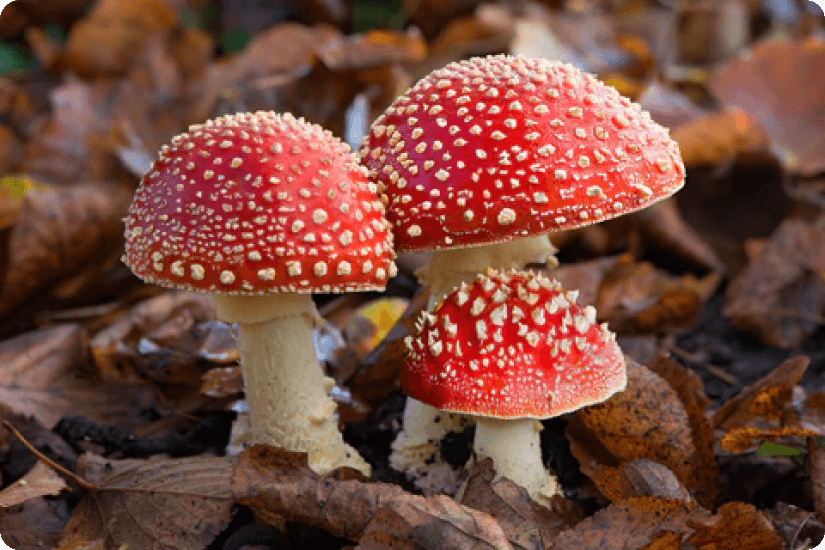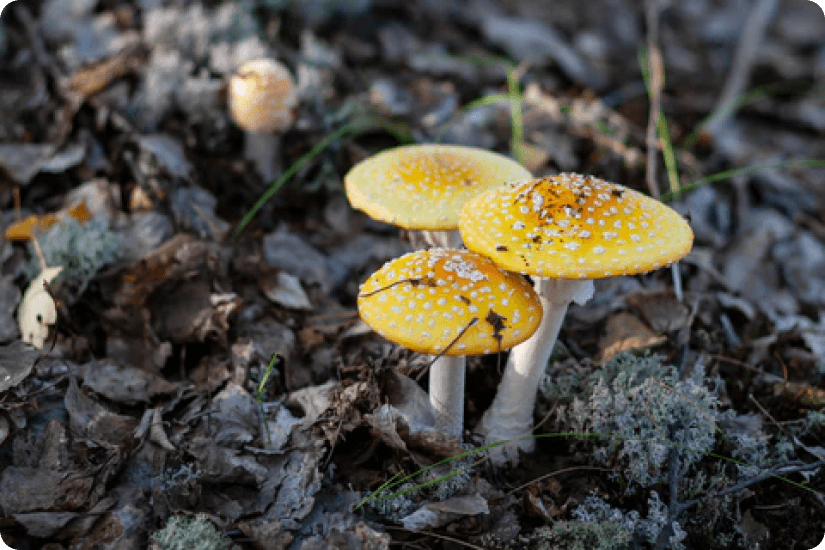With their almost cartoonish appearance, amanita muscaria have long intrigued nature enthusiasts, mycologists, shamans and hallucinogenic hobbyists” alike. In this article, we’ll provide a comprehensive guide on a variety of topics related to Amanita Muscaria – from what it is and what it does to its history and legal status.

What is Amanita Muscaria?
When you picture a classic mushroom, chances are you envision something straight out of a Mario video game—a big, bright red cap adorned with mysterious white spots. Interestingly enough, this iconic image is deeply rooted in our cultural consciousness. From Alice’s adventures in Wonderland to The Smurfs’ whimsical homes, amanita muscaria mushrooms have fascinated us for centuries.
Also known as “fly agaric,” amanita mushrooms boast a unique cap and stem structure. The cap comes in a range of colors, including white, yellow, brown, and that iconic red, often embellished with intricate patterns or scales. Some types have flat caps, while others are convex or bell-shaped. One key feature of amanita mushrooms is the presence of gills or pores beneath the cap, which produce spores.
While technically poisonous, fly agaric has been consumed throughout history in a variety of contexts. The name “fly agaric” originates from its use in combating flies – “agaric” refers to the mushroom’s fleshy, umbrella-shaped cap, while “fly” denotes its literal purpose in deterring flies. Shamans in Siberia and Northern Europe consumed the mushroom to induce altered states for spiritual and healing practices. It was also employed medicinally for its analgesic and sedative properties. In recreational contexts, Amanita muscaria provided hallucinogenic experiences, offering glimpses into altered realities. The mushroom continues to be symbolically significant in folklore, art, and cultural representations, preserving its intriguing connection to human consciousness and spirituality.
Chemical Composition
The two most notable components of Amanita Muscaria that impact the hallucinogenic effects are muscimol and ibotenic acid. Muscimol is the main psychoactive compound in Amanita mushrooms, while ibotenic acid plays more of a supporting role. Ibotenic acid acts as a “prodrug” to muscimol, meaning it helps form more muscimol through the process of decarboxylation, which is partially done by drying or boiling the mushrooms. This is important due to the undesired effects of ingesting higher levels of ibotenic acid. The effects are felt as a result of muscimol’s interaction with certain receptors in the brain, particularly the gamma-aminobutyric acid (GABA) receptors, which are involved in regulating neurotransmission. These are also the same receptors that alcohol interacts with which may be why some people report a sort of intoxicating effect.
As for ibotenic acid, its psychoactive effects are still being studied. Some speculation suggests that it may also have stimulant properties as a result of being an amino acid that affects the central nervous system when ingested. Ibotenic acid works with muscimol to create a psychoactive effect, but it is not the star of the show. In addition to muscimol and ibotenic acid, Amanita mushrooms also contain small amounts of muscarine, which is a toxic compound. Muscarine can activate muscarinic acetylcholine receptors in the body, leading to effects such as increased salivation, sweating, tears, and changes in heart rate. However, the overall impact of muscarine on the hallucinogenic effects of these mushrooms is considered minimal.

How will Amanita make me feel?
It is difficult to pinpoint exactly how a psychoactive dose of amanita will make you feel as interactions can vary from person to person based on the individual and the dosage. We’ll talk briefly later in the article about dosage, but there are two ends of the spectrum – microdosing or an amanita “trip.”
Micro-dosing for Wellness
Micro-dosing is becoming a more common way for people to consume amanita to boost mood, enhance creativity and restore sleep cycles. Taking smaller doses is a way to harness the potential benefits of Amanita muscaria while minimizing the intensity of its psychoactive effects. When taking a microdose, the feeling will be much more subtle with people often reporting elevated moods, calming states, and lucid dreaming.
- Lorem ipsum dolor sit amet, consectetur adipiscing elit. Mauris in ultricies purus, ac dignissim justo.
- Lorem ipsum dolor sit amet, consectetur adipiscing elit. Mauris in ultricies purus, ac dignissim justo.
- Lorem ipsum dolor sit amet, consectetur adipiscing elit. Mauris in ultricies purus, ac dignissim justo.
link
Lorem ipsum dolor sit amet, consectetur adipiscing elit. Mauris in ultricies purus, ac dignissim justo.

